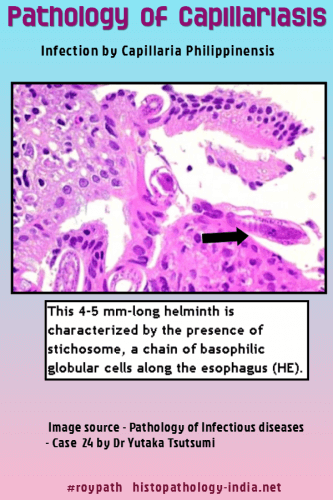|

Custom Search
|
|
Infectious Disease Online Pathology of Capillariasis
|
|
Capillariasis is an infection by Capillaria philippinensis, Capillaria hepatica, or Capillaria aerophila. In 1962, the first reported case of human intestinal capillariasis occurred in a previously healthy young man from Luzon in the Philippines, who subsequently died. At autopsy, a large number of worms were found in the large and small intestines. Capillaria philippinensis is a tiny nematode first described in the 1960 s as a pathogen causing severe diarrheal syndromes in humans. Capillaria philippinensis causes a malabsorption enteropathy that may be severe and even fatal. Infection with Capillaria hepatica presents the clinical picture of acute or subacute hepatitis with hypereosinophilia. Capillaria aerophila causes acute bronchitis, bronchiolitis, asthma, and cough. The life cycle of Capillaria philippinensis is not completely known, but infection is probably acquired by ingesting eggs or infective larvae in small fish. The organisms embed in the mucosa of the jejunum and interfere with absorption. Fatal infections are caused by extraordinarily heavy worm infestation. Larvae released from the female cause autoinfection. In severe infections generalized abdominal pain, diarrhea and pronounced borborygmi are followed by nausea and vomiting and intractable diarrhea, leading to severe malabsorption, cachexia, and death. The combination of muscular wasting, and loss of body fat makes intestinal peristalsis visible and outlines muscles and tendons through the skin. The mortality ranges from 7% to 20%. At autopsy the small intestine is indurated, thickened, and distended with fluid. One liter of fluid may contain 200,000 adults and larvae. Adults, larvae and eggs of Capillaria philippinensis are in the crypts and lamina propria of the duodenum, jejunum, and upper ileum. The diagnosis is made by identifying characteristic Capillaria philippinensis eggs in the stool. Capillaria hepatica is parasite of mammals.Adult worms in the definitive host (the rat) deposit eggs in the liver.If this host is eaten by a cat or dog, the eggs pass with the animal faeces.Eggs in the soil are eaten by humans and hatch in the small intestine.The larvae penetrate the intestinal wall and migrate to the liver, where they mature.Capillaria hepatica in adults are the foci of intense granulomatous reactions.The diagnosis is made by identifying eggs or adult worms in the liver.Mebendazole is the drug of choice.
|
|
|


